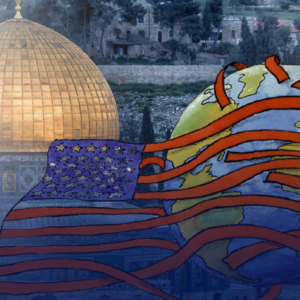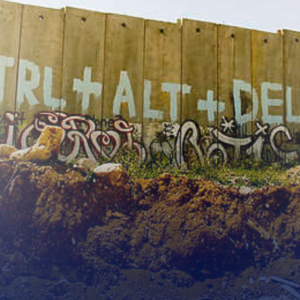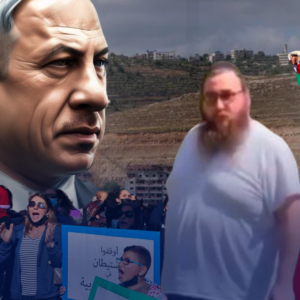All About Palestine VII: Occupied Palestine 2007-2022: The West Bank

All About Palestine VII: Occupied Palestine 2007-2022: The West Bank
Palestine. What was once a thriving, culturally, and religiously diverse land, now lies under the military occupation of a racist, colonial regime. In the early 1900’s, ‘Imperialism’ and ‘Zionism’ merged together in perhaps the greatest conspiracy in human history: to uproot a nation and establish a military outpost in the form of a settler-colony on the shores of West Asia, to serve the British Empire’s interests in the region.

All About Palestine VII: Occupied Palestine 2007-2022: The West Bank
Palestine. What was once a thriving, culturally, and religiously diverse land, now lies under the military occupation of a racist, colonial regime. In the early 1900’s, ‘Imperialism’ and ‘Zionism’ merged together in perhaps the greatest conspiracy in human history: to uproot a nation and establish a military outpost in the form of a settler-colony on the shores of West Asia, to serve the British Empire’s interests in the region.
Written by: Nadia Hojaij and Yahia Hassani | Copy Editors: Zainabrights | Design: Fatima El-Zein
The West Bank
In 1993, the PLO surprised the world by legitimizing Israel’s right to exist over the land that Zionist militias colonized in 1948 during the “Nakba,” which was around 78% of Palestine including West Jerusalem. In return, the PLO hoped for an independent state in the remaining 22% of Palestine consisting of the West Bank, East Jerusalem, and Gaza; which was occupied by Israel in 1967 during the “Naksa.”
The infamous negotiations for a two state solution, known as the Oslo Accords, called for Israeli withdrawal from the occupied territories in return for normalizing relations, and formally ending the First Intifada. However, in 2000, after Israel continued to expand its illegal occupation and settlement activities, tensions erupted into the Second Intifada. In 2005, the PA signed a treaty with Israel to quell the popular uprising and resume negotiations, informally ending the Second Intifada. However, despite continued Palestinian concessions and diplomatic efforts, the West Bank including East Jerusalem and Gaza remain under illegal Israeli military occupation.
After the Second Intifada, the PA pursued a state-building agenda in the West Bank in hopes for eventual statehood, while Israel continued to expand its illegal settlement activity in the occupied territory, further eroding the possibility of a two-state solution. Presently, there are 3.3 million Palestinians in the West Bank including East Jerusalem, with 700,000 Israeli settlers spread across 250 established settlements.
Israeli settlements and their settlers are illegal under international law, as they violate the Fourth Geneva Convention, which states
“The Occupying Power shall not deport or transfer parts of its own civilian population into the territory it occupies.”
However, hardline Zionists do not believe that any part of Palestine is occupied, which they believe was “granted to them by God.” Zionists use the bible as a legal document and refer to the West Bank area as “Judea and Samaria.”
Although every successive Israeli government has worked against a two-state solution by continuing to Judaize the occupied territories and expand Israeli settlements, the current Israeli government, led by the ultra-right wing Likud party, openly rejects an independent Palestinian state, which many of its ministers believe is tantamount to “suicide.”
In September 2023, Israeli PM Netanyahu came under fire for presenting a map of “The New Middle East” to the UN which depicted Israel over the entirety of Palestine.
In December 2023, Israeli Communications Minister Shlomo Karai said
"There will be no Palestinian state here. We will never allow the establishment of another state between the Jordan River and the sea. We will never return to Oslo.”
In March 2023, Israeli Finance Minister Bezalel Smotrich provoked outrage after giving a speech in Paris depicting a map of “Greater Israel” which included the entirety of Palestine, Jordan, and parts of Lebanon and Syria.
Areas A, B, and C
In the 90’s, the Oslo Accords carved the West Bank into a complex mosaic of areas. In 2000, the Wye Agreement updated the territorial distribution to the current configuration: Area A (18%) under PA civil and internal security control, Area B (22%) under PA civil and full Israeli security control, and Area C (60%) under full Israeli civil and security control. However, Israel has external security control over all the areas, essentially controlling the entire West Bank. Furthermore, these areas do not include East Jerusalem, which has been under full Israeli control since it was annexed in 1967. Areas A and B are non-contiguous and constitute 165 scattered “islands” across the West Bank. However, Area C is contiguous, holds most of the West Bank’s natural resources, and includes all of the Israeli settlements. Israel restricts Palestinian access, building, and development in Area C. In 2019, Israeli PM Netanyahu campaigned on promises to annex parts of Area C if elected, in flagrant violation of international law.

Israeli Settlement Expansion and Palestinian Home Demolition
Israeli settlements in the West Bank are heavily fortified Israeli-only housing complexes spread throughout the occupied territory. They are connected by a vast network of private roads and bridges that surround and circumvent Palestinian areas, as Palestinians are not allowed to enter.

The Israeli government uses a combination of legal and administrative measures, including subsidies, tax incentives and low cost utilities to incentivize Jewish Israelis to settle in these areas. Despite living outside Israel proper, Israeli settlers have Israeli citizenship while Palestinians nearby live under military occupation.
Since 1967, successive Israeli governments have continued to promote and implement a policy of settlement expansion in the occupied territories, despite international law and occasional US rebuke. In 1969, Israeli PM Golda Meir stated “The extent of Israel’s borders is where Jews live, not where there is a line on the map.” In the process, thousands of Palestinian-owned homes and structures have been demolished or seized, and tens of thousands of Palestinians have been forcibly displaced. The UN Office for Coordination of Humanitarian Affairs (OCHA) reports updated information and data from the occupied territories. According to OCHA, in 2022, 953 Palestinian-owned structures were demolished or seized, 1,031 Palestinians were forcibly displaced, and thousands of livelihoods were affected.
According to B’Tselem, Israel demolishes Palestinian structures under three main pretexts; “unlawful construction” (5,598 homes demolished since 2006), punishment (312 homes demolished since 2004), and alleged military purposes (1,996 homes demolished since 2004); forcibly displacing more than 23,700 Palestinians since 2004.
In 2003, 23-year-old American peace activist Rachel Corrie was crushed to death by an Israeli bulldozer while undertaking non-violent direct action to protect a Palestinian home from demolition. The Rachel Corrie Foundation has continued her legacy in the pursuit of peace, justice, and human rights around the world.
Separation Wall and Movement Obstacles
In 2002, Israel began building a 710 km long and 8 meter high concrete wall to act as a separation barrier between Israel and the West Bank. The wall has been ruled illegal by the International Court of Justice. Currently, the wall is about 64% complete. It is recognized as one of the most powerful symbols of Israeli apartheid and is often referred to as an Apartheid Wall.
Instead of building the wall along the internationally recognized 1967 boundary, known as the “green line,” Israel built 85% of the wall deep within the West Bank’s territory, confiscating large swaths of fertile Palestinian land, separating East Jerusalem from the West Bank, and severing inter-community ties. According to B’Tselem, a key factor in determining the wall’s route was the location of settlements, thereby laying the groundwork for the de facto annexation of most of the settlements and much land for their future expansion. The separation wall violates multiple human rights for Palestinians. The restriction of movement impacts their work, education, medical care, family ties, daily life and collective self-determination. Israeli human rights group B’Tselem provides an online interactive map titled “Divide and Conquer,” which depicts Areas A, B, and C, Israeli settlements, separation wall, checkpoints etc.
According to OCHA, the Israeli occupation currently operates 645 movement obstacles throughout the West Bank. They are used to control Palestinian pedestrian and vehicular movement through a policy of physical barriers, permit requirements, and other administrative restrictions. The movement obstacles include 220 checkpoints, 169 road gates, 91 earth mounds, 54 road barriers, 19 earth walls, and 3 trenches. Israeli settlers bypass all these movement obstacles through private roads which are forbidden to Palestinians.
Restrictions on Movement
Restrictions on movement severely hinder nearly all aspects of Palestinian society by requiring copious amounts of hours to reach areas only a few miles away. Such obstacles impact Palestinian welfare, education and employment, as well as impose a constant state of uncertainty in regards to planning, scheduling, and performing simple tasks. They are also a major factor in impeding economic stability and growth. Wael Shyuri, a dairy truck driver from Hebron, West Bank, needs two to three hours for a 26 mile trip to Jerusalem, limiting him to only one delivery a day instead of multiple deliveries. Mohammed Assadi, a Reuters journalist, states that a 60 mile journey from Jenin, in the northern West Bank, to Ramallah, can take up to five hours.
For Palestinians to enter Israel and East Jerusalem, they must first obtain a permit. Permits are not easy to obtain, are canceled on closure days, and can be denied or revoked without explanation or for “security” reasons. Sometimes, permits are denied to entire families and communities due to one individual in a means of collective punishment. This is despite Palestinians needing the permit for basic needs such as work, medical care, and family visits.
About 70,000 Palestinians from the West Bank work in Israel, mainly for construction, and enter through overcrowded checkpoints with a curfew to return by the day’s end. Tarek al-Taweel, a 30-year-old construction worker from the West Bank, begins his day at 3:30 am due to the three to four hours needed to arrive at his construction site in East Jerusalem; a destination only 20 miles away from his home.
Administrative Detention
The UN and international human rights organizations have regularly criticized Israel for its promiscuous use of administrative detention which systemically denies people’s right to a fair trial in violation of international law.
According to B’Tselem, Israel has routinely used administrative detention over the years, placing thousands of Palestinians behind bars, including minors, for periods ranging from several months to several years, without charge, accusation, nor disclosure of alleged evidence to them or to their lawyers.
According to Israeli human rights organization HaMoked, in November 2023, Israel was holding 2,070 detainees without trial or charge, out of the 6,809 Palestinian prisoners from the occupied territories.
According to Defense for Children Palestine (DCI), approximately 500-700 Palestinian children from the occupied West Bank are prosecuted every year through the Israeli juvenile military courts.
In 2018, a 16 year old prominent Palestinian activist, Ahed Tamimi, faced up to 10 years for slapping two armed Israeli soldiers who were wearing protective gear, after they shot her 15 year old cousin in the head. She served eight months in prison despite video evidence proving she posed no actual threat.
According to a July 2023 report by London based rights group Save The Children, 86% of children are beaten in Israeli detention and 42% are injured during their arrests, stating that “Palestinian children are the only children in the world who are systematically prosecuted in military courts” with an estimated 10,000 held in the Israeli military detention system over the past 20 years. For decades, Amnesty International has documented widespread cases of gruesome torture and degrading treatment of Palestinian detainees by Israeli authorities.
According to Human Rights Watch, more than 1,400 cases of torture have been filed since 2001. The UN Special Rapporteur for human rights in the occupied territory, Michael Lynk, stated
“I also call upon Israel to abolish its practice of administrative detention, release those detainees it presently holds, and strictly follow international law in the application of its security operations.”
Palestinian activist Khader Adnan was arrested twelve times and had been in and out of prison for nearly two decades, often held in administrative detention. He used hunger strikes to protest his arrests which sparked regional solidarity demonstrations and garnered worldwide attention. In May 2023, Khader was found dead in his cell after going on an 87-day hunger strike to protest his arrest without charge.
Open Fire Policy and Unlawful Killings
Over the years, thousands of Palestinians in the occupied territories have been unlawfully killed by Israeli forces as the entity enforced the occupation and policing activities, such as during house raids, arrests, demonstrations, detention, home demolitions, forced evictions, travel restrictions, at checkpoints and much more.
Israel’s open-fire policy allows unjustified use of lethal force against unarmed civilians due to its broad interpretation and artificial expansion of what constitutes a “life-threatening” situation. In 2022, Shireen Abu Akleh, a renowned Palestinian-American journalist who had covered the realties under occupation for more than 25 years, was killed by Israeli forces. She was shot in the head while covering an Israeli raid in the West Bank, despite being dressed in clearly marked “press” gear and standing near other journalists who were also shot. Shatha Hanaysha, a local journalist on the scene, reported there were no confrontations between Palestinian fighters and the Israeli army. She believed the group of journalists had been directly targeted, stating
“We were four journalists, we were all wearing vests, all wearing helmets. The Israeli occupation army did not stop firing even after she collapsed. I couldn’t even extend my arm to pull her because of the shots being fired. The army was adamant on shooting to kill.”
Her killing sparked widespread condemnation. Israeli forces then raided Shireen’s funeral procession and attacked hundreds of mourners and the palbearers.
The UN, US, and plethora of human rights groups have consistently pressed Israel to reconsider its open-fire rule to no avail. In 2021, Israel updated its open-fire policy to even allow soldiers to more easily open fire at suspected thieves and smugglers. According to B’Tselem, since 2000, there have been 2,740 Palestinians killed by Israeli forces in the West Bank. According to the UN, since 2008, there have been 156,940 Palestinians injured by Israeli forces in the West Bank.
B’Tselem provides an additional on-line interactive map with information on reports of abuse, harassment, shootings, and other violations of human rights displayed by location. In 2003, 22-year-old British peace activist and aspiring photographer Tom Hurndall was shot in the head by an Israeli sniper while attempting to rescue a Palestinian child who had been pinned down by gunfire.
Israeli Settler Violence
In the West Bank, the Israeli regime expands its territorial control and restrictions of Palestinian access through two main methods: “official” means and settler violence. Official means include issuing military orders that declare areas as closed military zones, natural reserves, or state land. Other areas are taken away by Israeli settler attacks on Palestinians and their property. The acquired areas are then used for settlement-expansion, farming, and industry. The UN, US, and human rights groups have consistently condemned Israeli settler-violence which, according to the UN, takes many forms including physical violence, shooting live ammunition, torching fields and livestock, theft and vandalization of property, intimidation, trespassing and grazing on private land.
In 2021, UN human rights experts said “Settler violence has always been an extremely disturbing feature of the Israeli occupation.” In 2022, they stated, “Armed and masked Israeli settlers are attacking Palestinians in their homes, attacking children on their way to school, destroying property and burning olive groves, and terrorizing entire communities with complete impunity.”
According to B’Tselem, the Israeli regime and its representatives actively aid and abet Israeli settler violence as part of a strategy to cement the takeover of Palestinian land. Settler violence is a form of government policy, supported by official state authorities with their active participation. UN experts stated that
“Disturbing evidence of Israeli forces frequently facilitating, supporting and participating in settler attacks, makes it difficult to discern between Israeli settler and State violence. The impunity of one is reinforced by the impunity of the other.”
They further added,
“The ubiquity of these attacks, and the credible reports of the Israeli military’s passivity in combating this violence, has deepened the atmosphere of fear and coercion throughout the West Bank. We are very troubled by the failure of Israel, the occupying power, to exercise its substantial obligations under the Fourth Geneva Convention, including Article 27, to protect the population under occupation.”
A recent OCHA report added that in almost half the cases, Israeli security forces “accompanied or actively supported” the attackers. According to Yesh Din, an Israeli human rights group, 91 percent of investigations into settler attacks against Palestinians between 2005 and 2019 were closed by the Israeli authorities with no charges filed. In recent years, Israeli-settler attacks have been increasing at an exponential rate, especially during the 2023 Israel-Palestine War, while 2022 was the previous record high with over 660 Israeli settler attacks recorded by the UN.

West Bank Resistance
Over the years, Israel’s continued settlement-expansion, restrictions on movement, home demolitions, forced evictions, arbitrary detention, unlawful killings, arrests, raids and the military occupation in general, have become a constant source of anger, frustration, and resentment by Palestinians. Israel’s false promises, broken commitments, and unaccountable violations of international law, have led to an increase in tension, hostilities, and violence between Palestinians and Israeli occupation forces.
In this atmosphere, a new generation of young Palestinian youth in the West Bank, hopeless of the PA’s fruitless diplomacy and decades of negotiations that led nowhere, began to mobilize and embrace their internationally recognized right to armed struggle against Israeli military occupation.
In 2022, The Lions Den and Jenin Brigades emerged, beginning a new era of Palestinian resistance in the occupied West Bank in response to increased Israeli military incursions throughout the territory.
The piece you just read is a part of a larger report on Palestine. Each day we will delve into a different aspect.
SOURCES
- What Price Israel, Alfred Lilienthal, Pages 148-150
If you value our journalism…
TMJ News is committed to remaining an independent, reader-funded news platform. A small donation from our valuable readers like you keeps us running so that we can keep our reporting open to all! We’ve launched a fundraising campaign to raise the $10,000 we need to meet our publishing costs this year, and it’d mean the world to us if you’d make a monthly or one-time donation to help. If you value what we publish and agree that our world needs alternative voices like ours in the media, please give what you can today.





